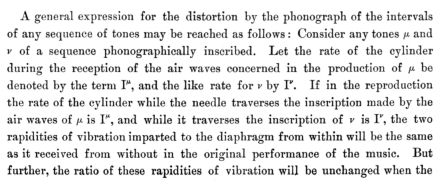Traditional Hopi Songs - online book
Native American Songs With Sheet Music, Notation & Commentary
| Share page | Visit Us On FB |
|
THE PHONOGRAPHIC METHOD 29
storage battery. An account of this test is given in an appendix to my paper on the Chinese Musical System. The test sequence employed (which could as well be one as another) was a sequence in unison without any interruption of the sound, that is, a single note held continuously until the inscription covered the cylinder. I sought to determine how far this varied in the reproduction from perfect constancy of pitch by tuning the phonograph note between two others (notes of the instrument called the Harmonical), which could be sounded at will for comparison, and which were one ninth of a tone apart. In some of the trials I found it impossible, even by the use of this delicate criterion, which I convinced myself would enable me to detect variations of very much less than this small fraction of a tone, to be sure that the phonograph note had changed its pitch at all during the entire reproduction. This unexpected result led me to preface the following study of the second collection of phonographic cylinders obtained among the Pueblo Indians by Dr. Fewkes, who this time used an electro-motor and storage battery, with a series of tests not psychological but physical. I endeavored both to find the principal limitations of the instrument by the trial of various conditions of inscription and reproduction, and to determine the degree of exactness of its best performance. The method consisted mainly in noting the amount of variation in the rapidity of the pulsations of sound called beats produced between a phonographic reproduction of a note held continuously and another note known to be of constant pitch. |
||
 |
||